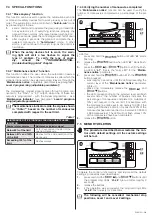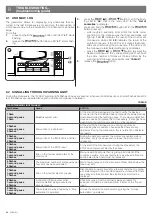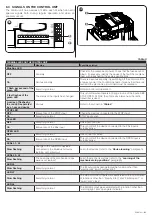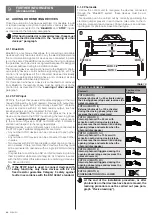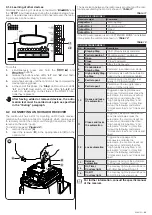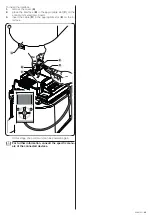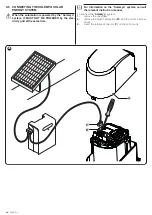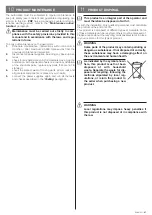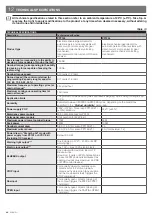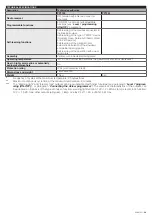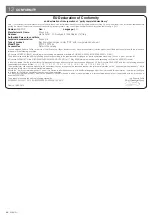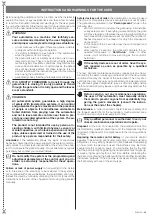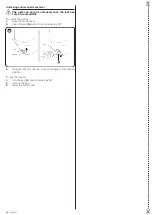
ENGLISH –
33
&
&
INSTRUCTIONS AND WARNINGS FOR THE USER
Before using the automation for the first time, ask the installer to
explain the origin of any residual risks and take a few minutes
to read this instruction manual and warnings for the user given
to you by the installer. Store the manual for future reference and
hand it to the new owner when transferring the automation.
a
WARNING!
Your automation is a machine that faithfully exe-
cutes commands imparted by the user. Negligence
and improper use may lead to dangerous situations:
–
do not manoeuvre the gate if there are people, animals
or objects within its range of operation
–
it is strictly forbidden to touch parts of the automation
while the gate or door is moving
–
the photocells are not a safety device but only an aux-
iliary aid to safety. They are built using highly reliable
technology but, in extreme conditions, may malfunction
or even become defective. In certain cases, the defect
may not be clearly evident. For these reasons, it is im-
portant to follow all the instructions given in this manual
when using the automation
–
periodically check that the photocells work properly.
a
IT IS STRICTLY FORBIDDEN to transit through the
gate while it is closing! It is only possible to transit
through the gate when it is fully open and the leaves
are at a standstill.
a
CHILDREN
An automation system guarantees a high degree
of safety. With its detection systems, it can control
and guarantee the gate’s movement in the presence
of people or objects. It is nonetheless advisable to
forbid children from playing near the automation
and not to leave remote controls near them to pre-
vent any unwanted activation of the system. The au-
tomation is not a toy!
The product is not intended for use by persons, in-
cluding children, with limited physical, sensory or
mental capacities, or who lack experience or knowl-
edge, unless supervised or trained in the use of the
product by a person responsible for their safety.
Anomalies:
if the automation shows any signs of anomalous
behaviour, disconnect the power supply to the system and man-
ually unlock the motor (see instructions at the end of the chap-
ter) to manoeuvre the gate manually. Do not attempt any repairs
personally but contact your trusted installer.
l
Do not modify the system or the programming and
adjustment parameters of the control unit: your in-
staller is exclusively responsible for these opera-
tions.
Failure or lack of power supply:
while waiting for the install-
er to intervene or the electricity to be restored, if the system is
not equipped with back-up batteries, the automation can none-
theless be used by manually unlocking the motor (consult the
instructions at the end of the chapter) and moving the gate leaf
manually.
Safety devices out of order:
the automation can also be used
when one or more safety devices are defective or out of order.
The gate can be operated in the “
Person present
” mode in the
following way:
1.
send a command to operate the gate using a transmitter
or key selector, etc. If everything works normally, the gate
will move regularly, otherwise the warning light will flash a
few times and the manoeuvre will not start (the number of
flashes depends on the reason for which the manoeuvre
cannot start)
2.
in this case, within 3 seconds press the control again and
hold it down
3.
after roughly 2 seconds, the gate will complete the re-
quested manoeuvre in “
Hold-to-run
” mode, in other
words, it will continue to move so long as the control is
held down.
m
If the safety devices are out of order, have the sys-
tem repaired as soon as possible by a qualified
technician.
The test, periodic maintenance and any repairs must be docu-
mented by the person carrying out the work and the documents
must be stored by the owner of the automation. The only inter-
ventions the user may carry out periodically include cleaning of
the photocell glass components (use a soft and slightly damp
cloth) and removing any leaves or stones that may obstruct the
automation.
m
Before carrying out any maintenance operations,
the user of the automation must manually unlock
the motor to prevent anyone from accidentally trig-
gering the gate’s movement (consult the instruc-
tions at the end of the chapter).
Maintenance:
in order to ensure constant levels of safety and
the longest useful life for the automation, routine maintenance
must be carried out (at least every 6 months).
l
Only qualified personnel is authorised to carry out
checks, maintenance operations and repairs.
Disposal:
at the end of its useful life, the automation must be
dismantled by qualified personnel and the materials must be
recycled or disposed of in compliance with the local regulations
in force.
Replacing the remote control battery:
if your remote control
appears to be working poorly after some time, or stops working
altogether, it may simply depend on flat batteries (depending
on how much the device is used, the batteries may last from
several months to over a year). You will notice this by the fact
that the indicator light signalling the transmission fails to light up,
is weak or lights up only for a short time. Before contacting the
installer, try replacing the battery with that of another transmitter
that works properly: if the anomaly is resolved, simply replace
the flat battery with one of the same type.

